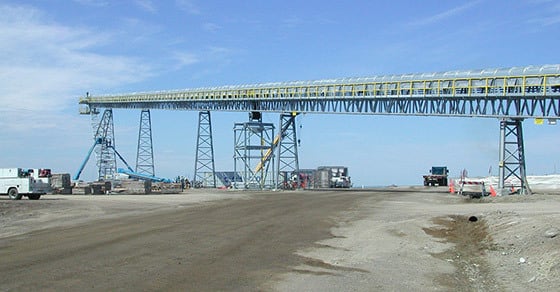The needs of a bulk solids handling operation can vary significantly and are often incredibly specific from one application to the next. As a result, customization has become a cornerstone of bulk material handling systems, allowing the trough conveyor to be expertly applied to any operation.
The ability to customize a system with precision can promote optimal efficiency, reduce downtime, and lower maintenance costs. It also prolongs equipment life, reduces the need for clean-outs, encourages process automation, and more; a well-designed handling system creates a seamless production facility, whatever the application may be.
The customizations available for trough conveyors are as varied and diverse as the materials these systems handle. Some of the most common options are listed here.
Trough Conveyor Belt Cleaning Options
Belt cleaners are an essential tool in prolonging conveyor belt life and protecting pulleys, along with other components. Furthermore, a well-designed approach can significantly reduce downtime and maintenance requirements.
Several options and designs exist for belt cleaners. Commonly used implements include:
Self-cleaning Tail Pulley
Self-cleaning tail pulleys prevent material from getting pinched between the pulley and the belt, to avoid buildup and excess wear.
Various self-cleaning tail pulley designs are available on the market, including wing pulleys, chevron pulleys, spirals, and more.
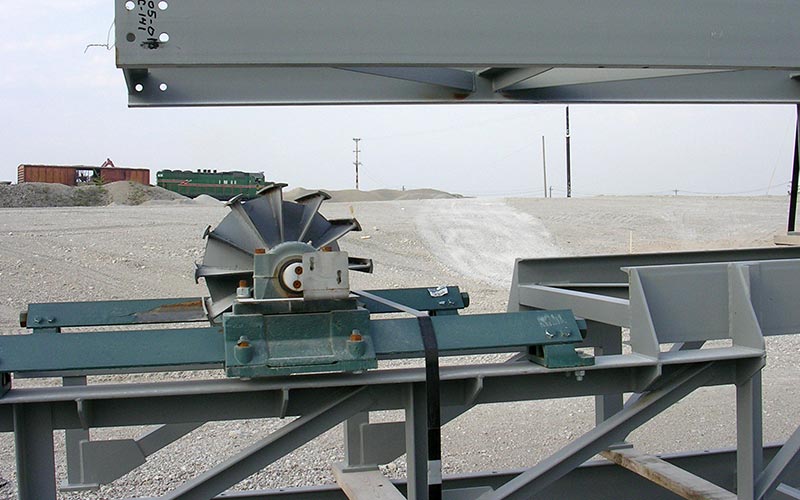
A wing pulley, as shown on this trough conveyor, is designed to shed material so that it doesn’t get trapped between the belt and pulley.
Return Side Belt Plow (V-Plow)
The return side belt plow, also commonly called a V-plow, is another belt cleaning option. This v-shaped “plow” discharges fugitive material off the belt prior to the tail pulley, protecting the pulley and belt.
While many manufacturers use only a self-cleaning tail pulley when fugitive material is a concern, FEECO recommends employing both the self-cleaning tail pulley and the v-plow for optimal protection of the tail pulley and belt.
Dual belt cleaners
Dual belt cleaners are an ideal option for materials with a higher moisture content, or that may exhibit stickiness, requiring more aggressive belt cleaning. Dual belt cleaners prevent material from traveling to idlers and other components through the use of a primary and secondary cleaner.
Idler Options
Idlers are the support mechanism for the belt. The Conveyor Equipment Manufacturers Association, better known as CEMA, sets forth the industry standard for best practices in idler dimensions, load, and capacity.
Note: not all conveyor manufacturers follow CEMA standards, so this should be a consideration in the buying process.
A trough conveyor may utilize a variety of idler types:
- Troughing idlers or Carrying idlers: for supporting the main body of the conveyor belt
- Impact idlers: for providing additional support under the loading area
- Transition idlers: for transitioning the belt between angled and flat as it moves around pulleys
- Training idlers: for keeping the belt aligned
- Flat return idlers: for supporting the return side of the belt
Within these divisions, idlers are available in many different configurations, with adjustable angles, various facings, seal types, and more.
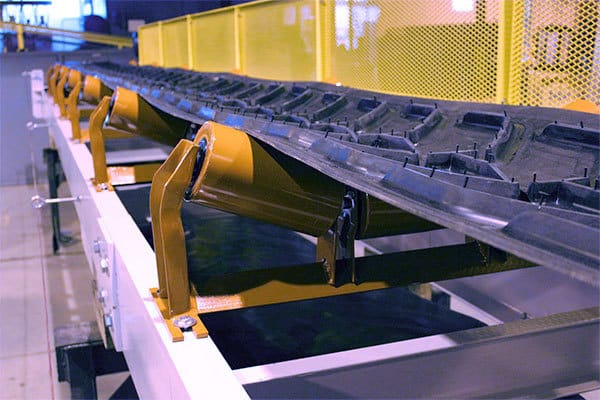
Cleated belting on 20 degree steel roll carrying idlers.
Composite Idlers
Idlers are generally constructed out of steel. However, steel is not always the best fit, such as when working with abrasive or corrosive materials. In instances such as these, composite idlers offer an excellent alternative.
Composite idlers can be constructed from a number of different materials, the choice of which is dependent on the application. In all cases, composite idlers offer several advantages over steel:
- Lighter weight
- Longer life
- Improved resistance to abrasion and corrosion
- Reduced opportunity for material buildup
Impact Beds
Impact beds, sometimes also called cradles, can be a better option over idlers in some situations, providing extra support for heavy loading; impact beds are beneficial when large or heavy pieces of material will be loaded onto the belt, or, when heavy material will be loaded from a greater height, causing more forceful impact with the belt.
Skirtboards
Skirtboards are frequently used to aid in material containment and dust management. Skirtboards run parallel to the conveyor along the interior of the belt in order to keep material from making its way off of the conveyor.
Skirtboard side plates are available in carbon steel or stainless steel. Optional liners can be provided in AR400, tungsten carbide, or UHMW, as well as non-stick liners such as teflon. The portion of the skirtboard in contact with the belt is typically rubber and can be upgraded to a high-temp rubber if needed.
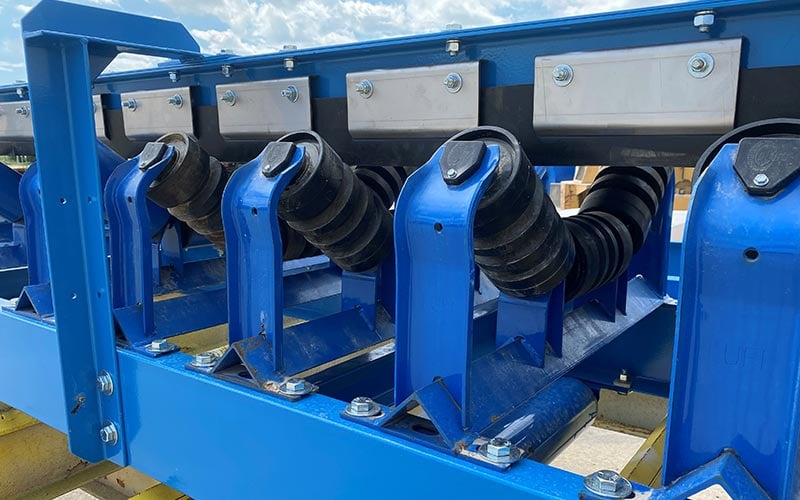
Skirtboard on trough conveyor with rubber disc impact idlers (belt not yet installed)
Trough Conveyor Frames
When it comes to the support structure of the conveyor, there are two generally accepted options: truss frames and channel frames.
Truss Frames
Truss-style frames are available in several depths, allowing for long spans between support points.
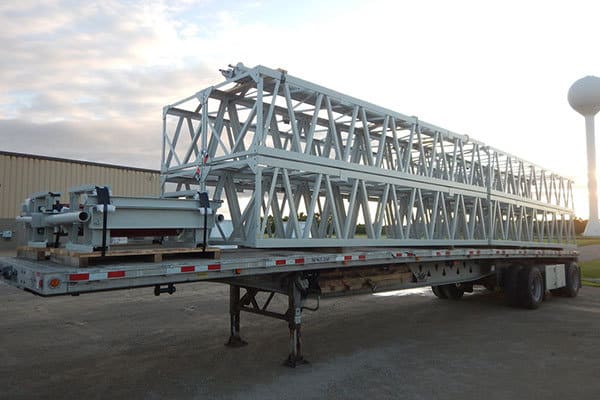
Truss frames awaiting shipment
Channel Frames
When the conveyor will be located close to grade, or long spans between support points are not required, channel-style frames provide an alternative frame option.
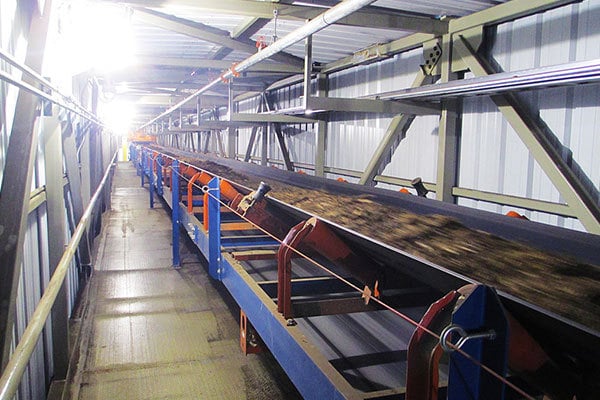
Channel frame conveyor
Surface Treatment
One of the most important aspects of a conveyor system is the surface treatment. Since the equipment will regularly be in direct contact with the material, the materials of construction and paint/coating system should be carefully considered. The correct surface treatment will protect the equipment from abrasion and corrosion, while maintaining the longevity of the equipment.
Hundreds of options are available, from stainless steel, to galvanized, various paint systems, and more. The standard FEECO paint system for trough conveyors is a durable, single coat, direct to metal Epoxy Mastic.
As the component most in contact with the material being handled, belt type is also a critical consideration in trough conveyor design and selection, with many options available, including 2-ply, 3-ply, 4-ply, and 6-ply with various PIW (pounds per width-inch) ratings. Belt cover options include typical RMA grade I and II, with upgrades available for oil resistance, high temperatures, solar/UV protection, flame retardancy, chemical resistance, and more.
Instruments
Instruments can also provide added functionality and automation to a bulk handling system. This might include incorporating zero-speed switches (shaft mount or bucket motion detectors), e-stops, belt alignment switches, or even plugged chute switches for indicating a hopper backup.
Additional Customizations for Trough Conveyors
In addition to the customizations listed above, numerous other options are available for designing a bulk material handling system that meets exacting specifications. Other commonly employed customizations include:
Weather Covers
Weather covers, or even complete gallery enclosures, can add major value when handling in the elements. Covers protect material from exterior precipitation, as well as from becoming windblown. Partial, full, or three-quarter covers can completely cover the system, or provide access to idlers where needed.
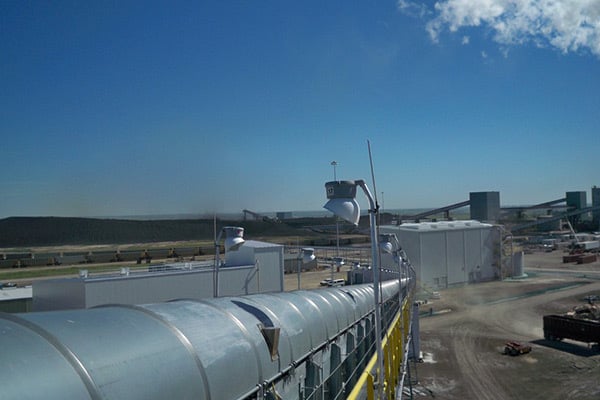
Full conveyor covers protect material from becoming windblown
Guarding
As a safety feature, guarding should not be overlooked. While the guarding on a system may be regulated in some cases, in others, it is up to the system owner/operator to protect workers from moving parts. Guards are available for nearly every part of the trough conveyor to ensure moving parts and pinch points are not accessible without dismantling the conveyor. FEECO can accommodate both OSHA and MSHA regulations for proper guarding.
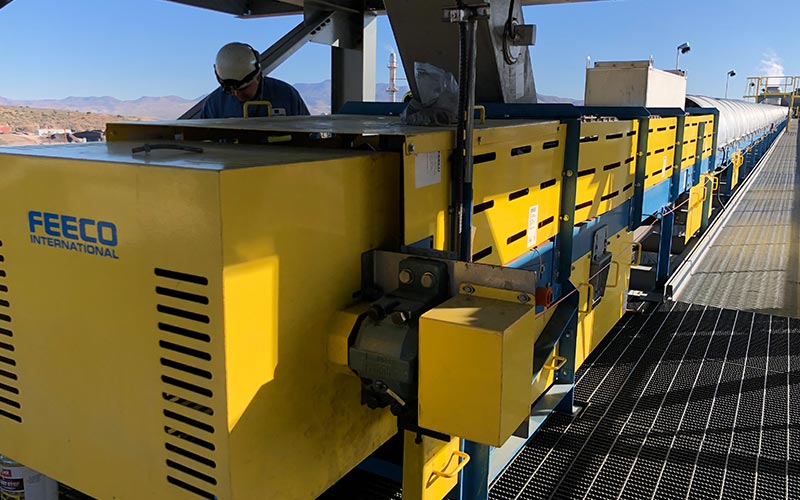
Guarding at the tail end of a trough conveyor, guarding the tail pulley and skirtboard idlers
Conclusion
Trough conveyors are the backbone of modern industrial processing facilities. Their potential for customization can lend seamless fluidity to any operational facility.
Choosing the right equipment customizations may not always be clear; in cases such as this, working with a trough conveyor manufacturer experienced in many industries can provide essential guidance during the system design stages.
FEECO is a leader in custom material handling equipment and engineered systems. With expertise that traverses nearly every industry, our systems are designed with the characteristics of the unique application and material at hand in mind. For more information on our bulk solids handling capabilities, contact us today!



